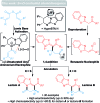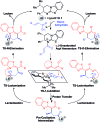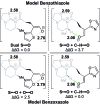Non-bonding 1,5-S···O interactions govern chemo- and enantioselectivity in isothiourea-catalyzed annulations of benzazoles
- PMID: 28567263
- PMCID: PMC5450589
- DOI: 10.1039/c6sc00940a
Non-bonding 1,5-S···O interactions govern chemo- and enantioselectivity in isothiourea-catalyzed annulations of benzazoles
Abstract
Isothiourea-catalyzed annulations between 2-acyl benzazoles and α,β-unsaturated acyl ammonium intermediates are selectively tuned to form either lactam or lactone heterocycles in good yields (up to 95%) and high ee (up to 99%) using benzothiazole or benzoxazole derivatives, respectively. Computation gives insight into the significant role of two 1,5-S···O interactions in controlling the structural preorganization and chemoselectivity observed within the lactam synthesis with benzothiazoles as nucleophiles. When using benzazoles the absence of a second stabilizing non-bonding 1,5-S···O interaction leads to a dominant C-H···O interaction in determining structural preorganization and lactone formation.
Figures









Similar articles
-
Cooperative Palladium/Isothiourea Catalyzed Enantioselective Formal (3+2) Cycloaddition of Vinylcyclopropanes and α,β-Unsaturated Esters.Angew Chem Int Ed Engl. 2022 Jun 20;61(25):e202202621. doi: 10.1002/anie.202202621. Epub 2022 Apr 28. Angew Chem Int Ed Engl. 2022. PMID: 35389553 Free PMC article.
-
Multiple roles of aryloxide leaving groups in enantioselective annulations employing α,β-unsaturated acyl ammonium catalysis.Chem Sci. 2018 May 4;9(21):4909-4918. doi: 10.1039/c8sc01324a. eCollection 2018 Jun 7. Chem Sci. 2018. PMID: 29910944 Free PMC article.
-
Insight into Isothiourea-Catalyzed Enantioselective Addition of Saturated Esters to Iminium Ions.Chem Asian J. 2019 Dec 2;14(23):4322-4327. doi: 10.1002/asia.201901163. Epub 2019 Nov 6. Chem Asian J. 2019. PMID: 31646734
-
Exploring the Benzazoles Derivatives as Pharmacophores for AChE, BACE1, and as Anti-Aβ Aggregation to Find Multitarget Compounds against Alzheimer's Disease.Molecules. 2024 Oct 9;29(19):4780. doi: 10.3390/molecules29194780. Molecules. 2024. PMID: 39407708 Free PMC article. Review.
-
Microwave Assisted Synthesis of Biorelevant Benzazoles.Curr Med Chem. 2017;24(41):4638-4676. doi: 10.2174/0929867323666161025142005. Curr Med Chem. 2017. PMID: 27781941 Review.
Cited by
-
Generation and Reactivity of C(1)-Ammonium Enolates by Using Isothiourea Catalysis.Chemistry. 2021 Jan 21;27(5):1533-1555. doi: 10.1002/chem.202002059. Epub 2020 Nov 10. Chemistry. 2021. PMID: 32557875 Free PMC article. Review.
-
One-Pot Access to Functionalised Malamides via Organocatalytic Enantioselective Formation of Spirocyclic β-Lactone-Oxindoles and Double Ring-Opening.Molecules. 2024 Jul 31;29(15):3635. doi: 10.3390/molecules29153635. Molecules. 2024. PMID: 39125040 Free PMC article.
-
Cooperative Palladium/Isothiourea Catalyzed Enantioselective Formal (3+2) Cycloaddition of Vinylcyclopropanes and α,β-Unsaturated Esters.Angew Chem Int Ed Engl. 2022 Jun 20;61(25):e202202621. doi: 10.1002/anie.202202621. Epub 2022 Apr 28. Angew Chem Int Ed Engl. 2022. PMID: 35389553 Free PMC article.
-
Synthesis of Benzoxazoles, Benzimidazoles, and Benzothiazoles Using a Brønsted Acidic Ionic Liquid Gel as an Efficient Heterogeneous Catalyst under a Solvent-Free Condition.ACS Omega. 2019 Jan 7;4(1):368-373. doi: 10.1021/acsomega.8b02932. eCollection 2019 Jan 31. ACS Omega. 2019. PMID: 31459336 Free PMC article.
-
Catalytic Enantioselective [2,3]-Rearrangements of Allylic Ammonium Ylides: A Mechanistic and Computational Study.J Am Chem Soc. 2017 Mar 29;139(12):4366-4375. doi: 10.1021/jacs.6b11851. Epub 2017 Mar 10. J Am Chem Soc. 2017. PMID: 28230365 Free PMC article.
References
-
- Dua R., Shrivastava S., Sonwane S. K., Srivastava S. K. Adv. Biol. Res. 2011;5:120–144.
- Eicher T. and Hauptmann S., The Chemistry of Heterocycles: Structure, Reactions, Syntheses, and Applications, Wiley-VCH, Weinheim, Germany, 2nd edn, 2003.
-
- Keri R. S., Patil M. R., Patil S. A., Budagumpi S. Eur. J. Med. Chem. 2015;89:207–251. - PubMed
- Noel S., Cadet S., Gras E., Hureau C. Chem. Soc. Rev. 2013;42:7747–7762. - PubMed
- Bansal Y., Silakari O. Bioorg. Med. Chem. 2012;20:6208–6236. - PubMed
- Demmer C. S., Bunch L. Eur. J. Med. Chem. 2014;97:778–785. - PubMed
-
- Rodembusch F. S., Leusin F. P., da Costa Medina L. F., Brandelli A., Stefani V. Photochem. Photobiol. Sci. 2005;4:254–259. - PubMed
-
-
For selected recent examples, see:
- Cai Q., Li Z., Wei J., Fu L., Ha C., Pei D., Ding K. Org. Lett. 2010;12:1500–1503. - PubMed
- De Silva H., Chatterjee S., Henry W. P., Pittman Jr C. U. Synthesis. 2012;44:3453–3464.
-
Grants and funding
LinkOut - more resources
Full Text Sources
Other Literature Sources

